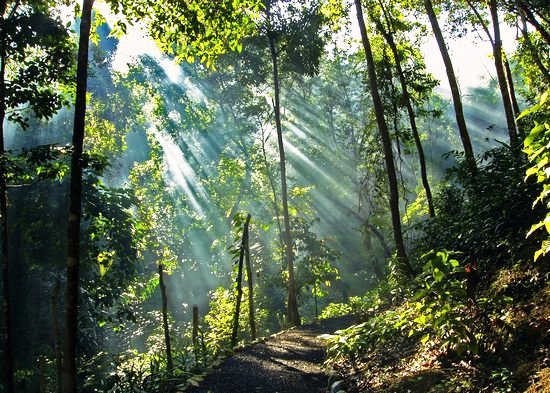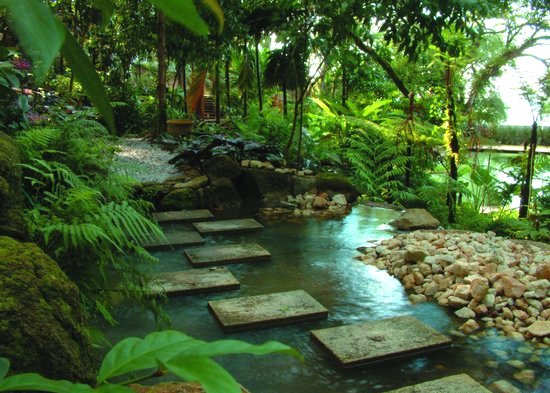| Penang's Tropical Spice Garden |
In my right hand, I squeezed the orange, plastic chopsticks and lifted the koay teow noodles into my mouth. Mark slurped up the last drops of his fresh nutmeg juice and raised his eyes to my drink. I kept my other hand tightly around the glass. It was automatic when I heard that sound.
“Can I just have a sip?”
“Nop.”
“Just a little.”
I shook my head and slid the glass of nutmeg juice closer to me. I had heard that line before. Of course, I wasn’t the first Southeast Asian in history to hear it. White guys have been following the Spice Route to this part of the world for 500 years trying to steal nutmeg.
Nutmeg– like almost everything else on this island – wasn’t here before 1786. That’s when Francis Light, in the name of the East India Company, leased the island from the Sultan of Kedah with some lofty promises he couldn’t keep. A few minor battles ensued, but Light prevailed and established the island as a free port to convince traders from around the region to help develop what he named “Prince of Wales Island.”
This was the late 18th century, a significant period in human history. For thousands of years prior, the Spice Route flourished between Europe, the Middle East, India, East Asia, and to the far corner of Southeast Asia to the Moluccas – The Spice Islands.
The tiny, remote, Spice Islands were home to the only source of nutmeg and clove, making these spices worth their weight in gold, and making whoever controlled them, extremely rich. Through the 17th century and into the 18th century, they were in the hands of the Dutch East India Company. But as the French and British grew more powerful in the region, they smuggled the nutmeg and clove seedlings to their own colonies, breaking the Dutch monopoly and ending the ancient Spice Route.
| Clove buds sprouting |
As a hilly, tropical island under control of the (British) East India Company, Penang was the perfect site for spice plantations. Under the direction of Irish botanist, Christopher Smith, thousands of nutmeg and clove seedlings were planted in the Air Itam Valley at the end of the 18th century. An image difficult to envision now that the valley is the most densely populated area on the island.
In addition to these most sought after spices, Smith was instrumental in bringing numerous other plants and cash crops to the island from around the region like cinnamon, coffee, cacao (cocoa), sugar palm, lempoyang (shampoo ginger), langsat, gandaria fruit, mangosteen, sago palm, pink guava, and much more. So many during the lucrative plant trade of Smith’s time, that to this day, no one is certain about the origin of a number of the plants on the island.
Following his work in Penang, Smith spent five years in the Spice Islands researching native plants and collecting seedlings to be shipped to the colonies of the East India Company. But his commitment to the work he had started in Penang led him back to the island to fulfill his dream of establishing the Company’s preeminent spice gardens.
However, it was not to be. Competition from Sumatra and other colonies, combined with the difficulty of growing nutmeg and clove trees, led the East India Company to sell their 16 Penang spice plantations in 1805. Not one to give up, Smith purchased all the plantations with the help of friend, James Scott. But only a year later, to his vehement protest, Smith was ordered by the Company back to England, leaving his spice gardens to be sold off to plantation owners.
Shortly after his journey home – still distraught from having to abandon his years of work in Penang and the Spice Islands – Smith died under mysterious circumstances, leading some to speculate that he had committed suicide.
 |
| Left: Vanilla bean vine, Right: Curry leaves |
200 years after Christopher Smith’s death, his legacy lives on in the amazing variety of plants on the island. In the nutmeg juice Mark and I each order to go along with our favorite beef koay teow soup. In the exotic fruits selling along the road in Balik Pulau. In our cendol dessert sweetened with palm sugar.
But if Christopher Smith were alive today, he would be even more astonished that from the foundations of his work, Penang now has Southeast Asia’s preeminent spice garden.
On the northwest corner of the island, on a hilly slope along the Straits of Malacca, Penang’s award winning Tropical Spice Garden features over 500 species of tropical flora, including many of the same spice plants Christopher Smith brought to the island two centuries ago.
On our most recent visit, we were guided through the gardens by Joseph – a man so passionate about spices, he could be the reincarnation of Smith. Joseph explained the role of spices in local remedies and cooking, as he snipped off leaves and seeds for us to smell and taste. I had no idea leaves from the cinnamon tree actually smell like cinnamon, and that Malays have traditionally used betel nut (the spice from the Pinang tree of which Penang is named for) in dishes to calm their guests during large gatherings.
After all the smelling of spices and talking about food during the tour, we quickly headed to the Tropical Spice Garden cooking class with Pearly Kee, who is an expert in the local cuisines of Chinese, Nyonya, Malay, and Indian.
 |
| Pearly demonstrating how to prepare belacan for toasting |
I whipped up a plate of belacan rice with chicken and a spicy cucumber kerabu salad that Mark devoured without lifting his head to say it was delicious, until he finished the last grain of rice.
I think if Christopher Smith were alive today, he would be very impressed with what Kat, Kenny, and the rest of the team have created on a jungle hillside in Penang.
Tropical Spice Garden is open from 9am - 6pm daily. We highly recommend the guided tour for a five sense experience.
And stop by Tree Monkey Restaurant to catch a glimpse of dusky leaf monkeys just sitting around...
Source: “Christopher Smith & Penang’s first Botanic Garden” – a talk by Marcus Langdon on October 1, 2011.
Some images provided by Tropical Spice Garden.


























